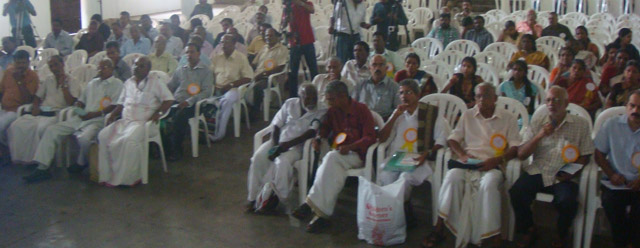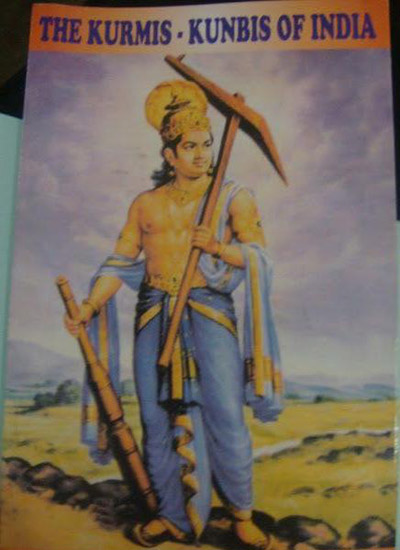The Rich Tradition of Konkani and The Kudumbis Of Kerala
By Walter Menezes
Pics by Ancy S. D’Souza
Bellevision Media Network
Ernakulam, 15 July 2012: After a successful National Seminar on Scripts and Languages of Modern India, with Special Reference to Konkani and three Regional Conferences in three different states of Goa, Karnataka and Maharashtra since inception a year ago in August 2011, Jagotik Konkani Songhotton (JKS) organized its fourth ‘Pradeshik Sammell’ in Kerala on July 8, 2012 at Maharaja College’s Centenary Hall, Ernakulam.

An umbrella organization with a membership of 126 Associations from 13 countries, the objective of JKS –presently headed by Tomazinho Cardozo – is to represent Konkani people and address issues globally to enrich and preserve Konkani in all serene beauty and variety and to ensure the transmission of the Konkani heritage and culture to future generations. The Kerala Conference not only discussed the situation and future of Konkani in Kerala and at the national and international level, but also focused on the ‘Konkani Identity among Konkani Tribals’ with references being made to the large Kudumbi presence in Kerala.
We – Jose Salvador Fernandes, the Secretary of Dalgado Konkani Akademi (DKA) who presented a paper at the conference and this writer – boarded the Mangala Lakshadweep Express on Friday night at Margao Station and 14 hours and 40 minutes later, we were warmly received by K Viswanathan, the Programme and Media Convener of the Kerala Conference at the Ernakulam Junction. Later, over lunch at the Indian Coffee House close to St. Teresa’s Convent, Viswanathan gave an overview of the Konkani situation in Kerala and disclosed that of the ten lakh Konkani population, the Kudumbis were a strong seven lakh in number and that an entire street just ahead of the Press Club Road was totally dominated by the Konkani business community.
The ‘Kerala Pradeshik Sammell’,which was attended by nearly a hundred enthusiastic Konkani lovers, including writers was inaugurated by Shri V. S. Achuthanandan, Leader of the Opposition and former Chief Minister of Kerala. Although late by more than an hour, his star-status was immediately evident from the manner in which he was treated by members of the press, both from the print and the electronic media, who had waited patiently at the entrance of the Centenary Hall. Although Shri Achuthanandan spoke in Malayalam and left quickly after lighting the traditional lamp, from reports appearing in the Kochi edition of The New Indian Express the following day, the former Chief Minister expressed his displeasure at the way the present UDF dispensation was ‘trying to sabotage the order to make Malayalam the first language in colleges.’ He also said that ‘language is the crux of human culture and any invasion over the linguistic rights is a crime.’
Shri Eric Ozario, Secretary General of JKS, while echoing the words of Dr. Anvita Abbi, (Professor of Linguistics, JNU who had attended the National Seminar on Scripts and Languages of Modern India) that “script variety is an asset of a language” reminded the audience that Konkani was written in five scripts – Nagri, Romi, Kannad, Malayalam and Perso-Arabic – and appealed to everyone to make a determined effort to speak Konkani in our day-to-day life. ‘Bhas uloilear matr ti bhas jivont urta (it is only when a language is spoken that it stays alive)’, Ozario added. Later, during the concluding ceremony, he placed a three-pronged strategy to revive the Konkani movement in Kerala before the local organizers: (a) creating awareness to preserve Konkani (b) to establish a Konkani Akademi with proper representation of all stake-holders and (c) to step up efforts to introduce Konkani subject in schools, especially in the light of Kerala Government’s willingness to do so.
Earlier, Shri K. K. Utharan, a retired Principal District and Sessions Judge and the Vice-President of JKS and Chairman of the Kerala Pradesh Conference welcomed and later presented his paper on the ‘Situation and Future of Konkani Language in Kerala’. Speaking in a Konkani language spiced with Malayalam words and referring to the 2001 Census which pegged the population of Konkani community in Kerala at less than a lakh, Shri Utharan lamented that ignorance on the part of the large Kudumbi population regarding their mother tongue was responsible for the dismal numbers in the census survey.
Shri Jose Salvador Fernandes who presented his paper on ‘Situation and Future of Konkani Language at National and International Level’ informed that Konkani has been one of the unsafe languages of the world as per UNESCO’s Atlas of the World’s Languages in Danger survey and impressed upon the writers of the need to publish books and magazines in the Malayalam script.
Shri Gopala Gowda of St. Aloysius College, Mangalore and a Kudmi leader, spoke at length on the ‘Konkani Identity among Konkani Tribals’ with special emphasis on the rich traditions of the Kudmi community of Kodiyal (Karnataka), including the revival of the use of‘ghumott’. ‘The Gowdas and the gumott are inseparable’, he informed.
Shri M. K. Sasi of Konkani Cultural and Research Centre, Shri P. R. Money, retired Deputy Director of Fisheries Dept, Shri K. K. Subramanian Master, poet and President of Konkani Sahitya Samajam, Shri A. G. Gopalakrishnan, novelist, Shri K. D. Sen, president of Bhatarhiya Konkani Vikas Sabha, Shri Sivananda Shenoy, poet and Shri L. Sumbramanian were among those who attended the conference and took part in the deliberations.
As the conference was progressing, this writer came across two books which had chapters shedding light on the migration of the Kunbis to Kerala. In Dr. Balagopal T. S. Prabhu’s book, A Konkani Saga – The Concise Cultural History of Konkani Speaking People of Kerala, we find the following: The Konkani speaking communities, other than Gowda Saraswat Brahmins, distributed in settlements along the coastal stretches of Kerala, are those of Kudumbis, Sonars, Vaniyas and Devadasis. Among these the major group who has played a key role in the destiny of the Saraswaths, is that of Kudumbis. They are also called as Mooppans, Kunbis, Konkana Sudras etc. It is generally believed that they also migrated from Goa along with the Saraswat Brahmins and settled in close proximity of the Saraswat settlements. It is further believed that the Kudumbis provided the manual work of the ships in which the Saraswat group sailed from Goa in search of new land. Such theories are built on the fact that the Kudumbi settlements are also located in the proximity of Saraswat settlement. Further, Kudumbi servants were generally seen working in Saraswat households.

Elsewhere in the same chapter, Dr. Balagopal writes, The Kudumbis speak Konkani with a characteristic tone similar to what is still heard in the remote villages of Goa. Their language has not much mix up of either Sanskrit or local Malayalam. The isolated community living has helped to keep the language pure. But this isolation has done much harm to their social development. While the Saraswat Brahmins have progressed economically through trade and socially through education, Kudumbis have remained economically and socially backward. Only during the last few decades sections of this community have come up in education through their own hard striving. It is time that the Saraswat Brahmins recognize the contribution made by the Kudumbis and share with them the benefits of the socio-economic progress. The Konkani language should become a strong bond between these communities who have shared a common destiny together for many centuries.
Another book, The Kurmis-Kunbis of India by Margao-based Pratapsinh Velip Kansar speaks of the kind hearted King of Cochin: In the first exodus, twelve thousand Konkani families from Goa came to Kochi. The King of Cochin state Shri Kesava Ramvarma (1565-1601 AD) assigned Cherai village to the Konkani speaking people free of cost. It was also a voluntary donation free from any payment of tax. Among the Konkanis, there were Brahmans, Vaisyas and Kudumbis
On page 118-119, we find this quote about Kudumbis from the Census Report of India, 1961 – Vol VII Kerala, p. 210: As to the fact that they were originally inhabitants of the area north of Goa, there can be no doubt for the language, the ornament and the mode of dress show striking similarities with the present inhabitants of that area, proclaiming a common origin. They are believed to have traveled by country crafts and landed at the sea port towns of Kerala which accounts for their concentration in places like Cranganore, Cochin, Parur, Kayamkulam, Alleppey, Purakkad and Quilon.
The Kudumbis of Kerala believe that their ancestors came from five different places of Goa: Nag Bhumi, Gardi Bhumi, Goa Nagri, Goa Dongri and Nara Bhumi. According to Kansar, these places could well be Nagve, Dogri near Old Goa and Narve while Goa Nagri and Gardi Bhumi could be places of Bardez-Pernem talukas where some Bhavati temples are located.
Mention is also made in this book about the Royal families’ fascination for the beaten rice for which the Kudumbis were famous: Their ability in pavilion making (mattova), beaten rice (phovu) and pappada (appla) is appreciated. For the Royal families of Cochin and Travancore, the beaten rice of Kudumbis was a specialty: therefore about 40 families were called from Alapuzha to Oruvathil Kotta at Thiruvanathapuram for making beaten rice during the reign of Maharaja Marthanda Varma.
The one-day ‘Kerala Pradeshik Sammell’ was significant – step to bring together Konkani writers and organizations from Kerala under one roof.
 Write Comment |
Write Comment |  E-Mail To a Friend |
E-Mail To a Friend |
 Facebook |
Facebook |
 Twitter |
Twitter |
 Print
Print | Comments on this Article | |
| Elizabeth, Ernakulam | Thu, June-30-2016, 8:21 |
| I have a doubt. How many Konkani speaking communities are there in Kerala? What are their major differences? | |
| Dayanand Gowda, vantimar, Ashwathapura, Mangalore Tq | Fri, April-17-2015, 5:19 |
| Any people can recognise by their language,Body shape, and their behaviors. Gowda is subcast of Kurmi. Kurmi is spelled kunbi, kudubi, kudumbi. They are all Aryan Culture. All Agriculturist are same and they have their own traditions. In Indian Historyfrom Vedic periods till date these people suffered a lot. Later Kurmis by one reason or other divided in to Muslims, Jains, Buddhists, And lastly Christians. Once a time Gowda Brahmns were very traditional. In present situation these people are very backward in education and political life. crore and crore vidya se meti Vidya melu. but there is no implortance to these vidya and those people belived this ocupation is behnd in society. | |
| Alphonse Mendonsa, Pangla/Abu Dhabi | Sun, July-15-2012, 11:20 |
| Dear Walter Menezes, thanks for this very informative report on Kerala Pradeshik Sammellana. It is nice to learn that a large population speak in Konkani and specially the Kudumbis, their origin, language, tradition. A lot to be done to bring Kudumbis to the main stream and as suggested Saraswat Bhramins must support and encourage Kudumbis in their development and revive konkani and create a strong bond between all konkani communities. Great report, and very very informative. thanks for sharing with Bellevision readers. | |



















